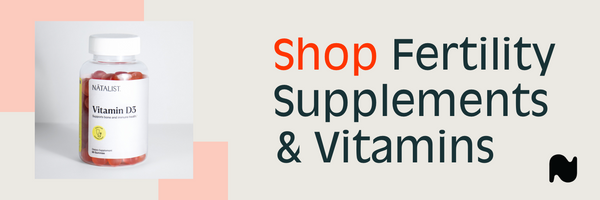Child Spacing From a Medical Perspective

An OBGYN breaks down the medical considerations, such as guidelines, outcomes, and optimal intervals, to keep in mind when planning gaps between children.
If you’re in full mommy mode, and your sleepless nights have gracefully transitioned into happier days—full of tickles and giggles—you may think, “Hmm, this isn't so bad, let’s try for baby number two!” And while there’s no harm in preparing by grabbing your Get Pregnant Bundle, let's first take a look at when it's truly safe to TTC.
What is child spacing?
Child spacing, also referred to as birth spacing, refers to the interval of time between the birth of one child and the birth of the next. This term is often used interchangeably with interpregnancy interval (IPI) which actually refers to the time between the end of one pregnancy—whether miscarriage or live birth—to the beginning of the next. For the purposes of our discussion, we will mainly reference the interpregnancy interval.
What is the optimal interpregnancy interval recommended by the medical community?
ACOG recommends an optimal interpregnancy interval of at least six months, but further acknowledges optimal spacing as 18 months since IPI’s less than 18 months are often associated with adverse outcomes. Although most US data supports this association, studies have not consistently shown a cause-effect relationship. This suggests that there may be additional factors contributing to the link between short IPI and adverse pregnancy outcomes.
Why does a short interpregnancy interval affect pregnancy and neonatal outcomes?
Many factors potentially explain this correlation, including a short or weak cervix, sibling competition for resources, and incomplete healing. A widely-accepted explanation is the maternal depletion hypothesis which suggests that maternal nutrients (particularly folate) aren't sufficiently replenished, thus leading to adverse outcomes.
What health outcomes are affected by a short interpregnancy interval?
- Recurrent miscarriage: The traditional recommendation to allow a IPI of at least three months after a miscarriage has fallen out of favor. A large meta-analysis (a study that combines the results of multiple independent studies) evaluated nearly one million patients who previously miscarried and determined that the risk of recurrent miscarriage was reduced with IPIs of less than six months.
- Preterm birth: Multiple studies have linked a short IPI to an increased risk of preterm birth. Although many of these studies have come under scrutiny, there remains a large body of evidence supporting this correlation.
- Low birth weight: A 2006 meta-analysis of ten studies showed that an IPI less than six months was associated with a 60 percent increase in risk of low birth weight when compared with IPI of 18 to 23 months.
- Neonatal and infant mortality: An association between short IPI and fetal, neonatal, or infant death has been suggested by several studies; however, findings have been inconsistent.
- Gestational diabetes: Pregnancies following a short IPI have been associated with higher rates of pregnancy-induced diabetes and obesity.
- Maternal anemia: The hypothesis of maternal nutrient depletion explains the correlation between short IPI and anemia. Women looking to achieve pregnancy after a recent pregnancy can benefit from iron supplementation.
How do child spacing guidelines differ for vaginal births versus cesarean births?
Most women should wait at least 18 months after birth to TTC. This 18 month waiting period is important regardless of whether the prior pregnancy was delivered vaginally or via cesarean. However, women with prior cesarean deliveries are at higher risk for adverse outcomes, mainly uterine rupture, than women with prior vaginal deliveries, so the IPI is much more imperative.
If a short IPI is bad, does that mean a long IPI is best?
Not necessarily. Although most poor outcomes have been correlated with a short IPI, both short and long IPIs have been associated with adverse pregnancy outcomes. A long IPI is typically defined as greater than 60 months.
So, what is the optimal interval between pregnancies?
The optimal IPI is unclear, but most organizations including the WHO and the United States Agency for International Development recommend an IPI > two and < five years. Two years was suggested over 18 months due to the United Nations Children's Fund (UNICEF) two year breast feeding recommendation. However, in the US, the data safely supports an IPI of 18 months to five years.
What if I’m older than 35, do these guidelines regarding IPI still apply?
With more women delaying childbearing, the age at first pregnancy is often later and can leave women feeling rushed and eager to add to their families. A shorter IPI of twelve months is an acceptable interval for women in this category,= and perhaps even shorter depending on your age. This balances the risk of infertility with the risk of poor pregnancy outcomes. Discuss your specific concerns regarding your age and child spacing with your OBGYN provider to come up with a plan that’s best for you.
What are other considerations to keep in mind when planning how far apart your children may be?
A short IPI not only affects pregnancies and babies, but also affects the family. Children who are adequately spaced are better prepared to begin kindergarten and generally perform better in school. This is likely due to dedicated time to each child from parents, which may lead to greater success and mastery of developmental skills.
The bottom line: it's up to you!
When deciding the right time to expand your family, there are many factors to consider. In addition to the physical effects of adequate child spacing, there are also emotional, financial, and social aspects to consider. Family planning and child spacing are personal conversations between yourself and your partner. You should move forward with having another child if and when it feels right to you. Although, it may be worth speaking to a healthcare provider before TTC to ensure there are no medical concerns to move forward with pregnancy. If you need additional support to comprehensively approach this topic, check out Parent Plans. When you’re ready to start TTC, we recommend tracking your fertile window via ovulation tests to better predict your chances of conceiving.
Reach Out, We're Here
Have questions about your order or products? For the speediest answer, check out our FAQ section. Need something else? Come find us below.
Please keep in mind our regular business hours; Monday-Friday, 9am-5pm CT.
Customer Support
support@natalist.com
Press Inquiries
media@everlyhealth.com
Business & Partnerships
team@natalist.com
Affiliates + Influencers
team@natalist.com
Job Openings
Careers Page
























